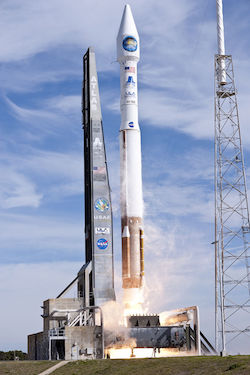
Access to Space
 The deafening roar of rockets and breath-taking pictures of far off worlds are exciting, but a huge amount of effort is required to even get to the launch pad. How do we get to space? And what can we do once we’re there? Both the government and private companies are coming up with answers to those questions.
The deafening roar of rockets and breath-taking pictures of far off worlds are exciting, but a huge amount of effort is required to even get to the launch pad. How do we get to space? And what can we do once we’re there? Both the government and private companies are coming up with answers to those questions.
Traditional Launch Providers: Tried and True, But Expensive
Most of the rocket launches in the United States over the past twenty years were provided by an organization called the United Launch Alliance (ULA). This organization provides launches on two different rockets: the Delta IV and the Atlas V. These rockets have a nearly flawless history. However, this reliability comes at a cost. Each launch costs about $225 million dollars.
The NewSpace Movement
The NewSpace Movement refers to space development that has happened over the past several decades that has not been led by the government. Examples of the NewSpace movement are companies like SpaceX and Blue Origin. These companies are pursuing a new technology in rocket launches: reusability. Traditional rocket launches discard the rocket after its fuel is consumed. Once the rocket burns up, it has historically been crashed back into the ocean. That’s like if every time you drove in a car, you had to buy a new one! That would be pretty expensive.
 SpaceX has shown that by landing the spent rockets intact, recovering and refueling them, they can be reused in future launches. This has dramatically reduced the cost of a single launch. The price for a SpaceX launch is under $100 million dollars. Even further drops in price are expected in the future. This change in the typical method of space exploration is what qualifies SpaceX as ‘NewSpace’.
SpaceX has shown that by landing the spent rockets intact, recovering and refueling them, they can be reused in future launches. This has dramatically reduced the cost of a single launch. The price for a SpaceX launch is under $100 million dollars. Even further drops in price are expected in the future. This change in the typical method of space exploration is what qualifies SpaceX as ‘NewSpace’.
On May 30th, 2020, SpaceX again changed the game of space exploration. It was a warm, humid afternoon at Cape Canaveral in Florida. Two NASA astronauts sat at the top of a SpaceX Dragon rocket. The astronauts, Bob Behnken and Doug Hurley, knew that their otherwise ordinary flight to the ISS would be historic. American astronauts had not launched on a rocket from US soil in nearly 10 years. The launch had been scheduled to happen earlier that week but had to be postponed due to poor weather. As the new launch time came, all conditions were favorable. As the rocket roared to life at 3:22 PM, Bob and Doug were lifted up into space to rendezvous with the International Space Station. NASA and its commercial partner SpaceX had made history. In their usual style, SpaceX reused the rocket that launched Bob and Doug on another cargo mission on July 20th, 2020.
The Space Launch System
The Space Launch System, or SLS, will be the most powerful rocket ever built. NASA, the United States’ government space agency, has been working on SLS since 2011. The goal of SLS is to provide the US with the capacity to send humans back to the Moon and on to Mars. The first planned launch of SLS will be in November 2021. This mission, Exploration Mission 1, will carry a test spacecraft on a 3-week journey around the Moon. This mission will also launch the LunaH-Map spacecraft developed at Arizona State University. The second SLS launch will carry a crew of astronauts to lunar orbit for several days. This will be the first human departure from low-Earth orbit since 1972. This mission is expected to take place after 2022.
The International Space Station: A Learning, Living Laboratory

The International Space Station (ISS) is one the most complicated engineering projects in history. The ISS is a huge space station and laboratory in low Earth orbit run by various countries working together. Construction of the ISS started in 1998 and was finished in 2011. It can support a crew of 6 astronauts when properly supplied. The ISS is expected to be in operation until 2028. Astronauts have lived continuously on the ISS since the year 2000, which makes it the longest-occupied spacecraft in history. The ISS is used to develop technology to support human spaceflight.
The Lunar Orbiter Platform Gateway
 If the Space Launch System is successful, NASA plans to develop a new space station in orbit around the Moon! It will be called the Lunar Orbiter Platform Gateway (or LOP-G). This station would support both robotic and human missions to moon’s surface. NASA intends to develop this station with international and commercial partners. It will also serve as a stepping stone for missions to Mars. If missions leave for Mars from orbit around the Moon, they need much less fuel to get there.
If the Space Launch System is successful, NASA plans to develop a new space station in orbit around the Moon! It will be called the Lunar Orbiter Platform Gateway (or LOP-G). This station would support both robotic and human missions to moon’s surface. NASA intends to develop this station with international and commercial partners. It will also serve as a stepping stone for missions to Mars. If missions leave for Mars from orbit around the Moon, they need much less fuel to get there.
Additional images via Wikimedia Commons. Illustration of the Space Launch System by Kevin Gill of Nashua, NH.

When active, the Space Launch System will be the most powerful rocket ever built.
Be Part of
Ask An Earth and
Space Scientist
By volunteering, or simply sending us feedback on the site. Scientists, teachers, writers, illustrators, and translators are all important to the program. If you are interested in helping with the website we have a volunteers page to get the process started.
